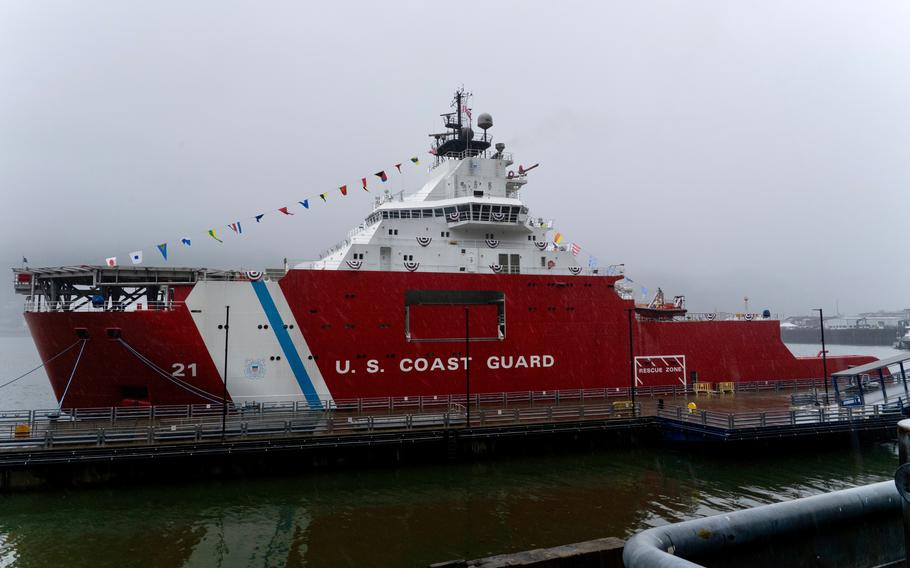
The U.S. Coast Guard Cutter Storis moored at Juneau, Alaska, on Aug. 10, 2025, where it was commissioned as the service’s third icebreaker. (Carmen Caver/U.S. Coast Guard)
The Coast Guard has commissioned a converted oil drilling support ship as its third icebreaker in what some officials said is a move to increase U.S. presence in the Arctic region while the service has 40 new ships built.
Adm. Kevin Lunday, acting commandant of the Coast Guard, said the icebreaker — named the USCGC Storis — would help bridge the gap between the service’s two older icebreakers and new ships scheduled to begin arriving in 2030.
“Storis adds vital capability to the U.S. polar icebreaker fleet at a critical time, when our adversaries are expanding their activities in and near U.S. waters, and the challenges and threats we face as a nation are growing more complex every day,” he said Sunday in Alaska during the commissioning ceremony.
Formerly named Aiquiv, the Royal Dutch Shell ship was purchased for the Coast Guard in 2024 for $125 million. It was given navigation, communications and defensive improvements, along with a new coat of paint in Coast Guard red and white colors.
“What we’re doing here today is we’re really just preparing to build our Arctic fighting force,” said Troy Edgar, deputy secretary of the Department of Homeland Security, which oversees the Coast Guard.
That force is still mostly in the planning and construction phase, defense and congressional leaders have said.
Congress last month approved a record $25 billion to buy 40 new cutters, including icebreakers. The first ship, the USCGC Polar Sentinel, is scheduled for delivery from Bollinger Mississippi Shipbuilding in 2030.
The Arctic has become a focus of military and economic competition between superpowers as climate change has led to receding ice in the region. The northern polar routes reduce travel times and allow ships an option to trade routes such as the Suez Canal in the Middle East.
The receding ice has also uncovered access points to massive natural resources — 90 billion barrels of oil and more than 1,700 trillion cubic feet of natural gas, according to the U.S. Energy Information Administration.
The Russians have reopened some far north Siberian military bases closed after the collapse of the Soviet Union in the 1990s. Though it is more than 900 miles from the Arctic Circle, China has declared its economic interests in the region make it a “near-Arctic state.” The two countries have operated joint military flotillas, including through the Bering Sea west of Alaska.
The United States has also bolstered its military forces in the region. Congressional proponents of a more assertive Arctic presence have said it is needed to protect American territorial rights and waters. Some House members said last year that new Coast Guard ships will close what some called “the icebreaker gap.”
Russia has several dozen icebreakers, ranging from the seagoing Arktika-class nuclear-powered ships to small diesel-powered vessels used to clear Russia’s many northern ports. China can operate up to five icebreakers in the Arctic.
The Coast Guard operates just two icebreakers other than the Storis. The 49-year-old USCGC Polar Star is the only heavy icebreaker and spends much of the year assigned to icebreaking duty in Antarctica to resupply scientific missions. The 26-year-old USCGC Healy, a medium icebreaker like the Storis, operates primarily in the Arctic region. The Navy does not have any icebreakers.
Polar Star is rated to break 6 feet of ice, and the Healy and Storis are rated for up to 4½ feet of ice, according to a Congressional Budget Office report.
Though the Storis commissioning was held in Juneau, Alaska, plans to homeport the ship in the Arctic will wait. Along with money for the new ships, Congress allocated $300 million to build new port facilities and buildings for additional personnel.
Until at least next year, all three Coast Guard icebreakers will remain homeported in Seattle.